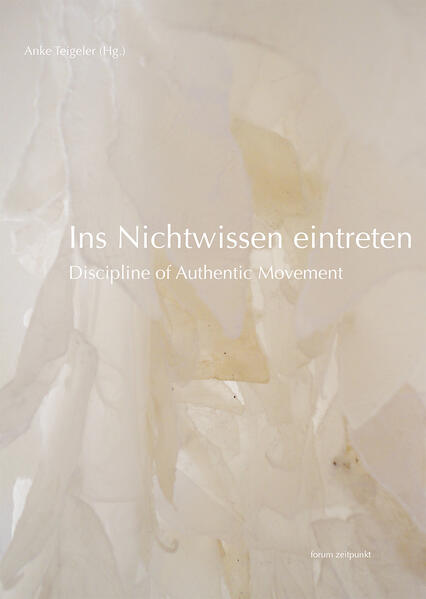
Zustellung: Mi, 23.07. - Fr, 25.07.
Sofort lieferbar
VersandkostenfreiBestellen & in Filiale abholen:
Ins Nichtwissen eintreten ermöglicht erstmals in deutscher Sprache einen facettenreichen Zugang zum Übungsweg Authentic Movement Discipline of Authentic Movement. Das Buch möchte ein vertieftes Verständnis dieser im Körper verankerten, auf mitfu hlender Beziehung basierenden Achtsamkeitspraxis
vermitteln. Die bewusste Verbindung und Resonanz des Einzelnen zu sich selbst, zur Gemeinschaft und zum Göttlichen sind dabei wesentlich. Zentrale Essays der Begru nderin Janet Adler und vielfältige Beiträge Lehrender
und Studierender verweben theoretische und erfahrungsorientierte Reflexionen der Entwicklung des Zeugenbewusstseins und der direkten Erfahrung miteinander. So ist eine Sammlung für Praktizierende und für Interessierte entstanden, die zu einer zusammenhängenden Annäherung an diese verkörperte Bewusstseins-Schulung beitragen möchte.
vermitteln. Die bewusste Verbindung und Resonanz des Einzelnen zu sich selbst, zur Gemeinschaft und zum Göttlichen sind dabei wesentlich. Zentrale Essays der Begru nderin Janet Adler und vielfältige Beiträge Lehrender
und Studierender verweben theoretische und erfahrungsorientierte Reflexionen der Entwicklung des Zeugenbewusstseins und der direkten Erfahrung miteinander. So ist eine Sammlung für Praktizierende und für Interessierte entstanden, die zu einer zusammenhängenden Annäherung an diese verkörperte Bewusstseins-Schulung beitragen möchte.
The anthology Ins Nichtwissen eintreten enables, for the first time, a diverse access to the Discipline of Authentic Movement in the German language. The book allows for a deepened understanding of what this practice of mindfulness, which is anchored in the body and based on resonant, compassionate relationship, can mean for the conscious relationship of the individual to herself, to the collective and to the numinous. Through diverse contributions by teachers and practitioners as well as translations of multiple essential original texts by founder Janet Adler a collection of texts has been created, that connects theoretical and experience-oriented reflections on the development of witness consciousness and direct experience, thus contributing to a coherent general view. The 18 contributions are divided into five sections: The first part provides multiple perspectives for the understanding of the Discipline of Authentic Movement in regard to its determination as a mystical practice and vividly describes essential forms, processes and main aspects regarding its content. The following three parts shed light on the Discipline of Authentic Movement in terms of the three branches that conjoin in it and that it derives from: healing, dance/art and mysticism. The healing potential is examined under psychotherapeutic considerations regarding the significance of embodiment, presence, compassion and trust into not-knowing. Both the relevance of spiritual experience in the context of traumatic experiences and experiences with body and spirituality in the Discipline under the diagnosis of breast cancer are being explored. The creative potential is expressed by outlining the development of the Discipline of Authentic Movement in regard to dance as an artistic, creative and bodily origin. Furthermore, the practice is described in the context of the process of embodiment in visual art and is presented through works of art. `BodywordsŽ speak poetry, which is born out of direct experience and which is related to different levels of consciousness. The circle is described as the form inviting for ritual in the Discipline of Authentic Movement, becoming a container and a ritual for that, which is. Comparing and distinguishing from other spiritual paths, essential aspects of mystical traditions are being identified and the Discipline is determined clearly as a western mystical discipline. Finally, the last part invites for a deepened theoretical reflection in order to contribute to further exploration of this practice of embodied relational mindfulness.
Jetzt reinlesen: Inhaltsverzeichnis(pdf)Mehr aus dieser Reihe
Produktdetails
Erscheinungsdatum
09. April 2018
Sprache
deutsch
Seitenanzahl
292
Reihe
zeitpunkt musik
Herausgegeben von
Anke Teigeler
Verlag/Hersteller
Produktart
kartoniert
Abbildungen
11 Farbabb.
Gewicht
566 g
Größe (L/B/H)
241/172/17 mm
ISBN
9783954902590
Entdecken Sie mehr
Pressestimmen
Man kann mit Fug und Recht sagen, dass hier ein Grundlagenwerk enstanden ist, in dem besonders dieser spezielle Ast am Baum` der authentischen Bewegung, nämlich die Discipline of Authentic Movement, erstmals genauer beschrieben wird.
[. . .]
Das Buch ist ein mehr als gelungener Versuch, dem nachzugehen, was Erfahrungswissen sein kann, und zu zeigen, wie es gelingt, dieses zur Mehrung unseres kollektiven Wissenspools nicht nur überzeugend, sondern auch überprüfbar zusammenzutragen. Und letztlich ist diese Sammlung - einschließlich des Gedichtes auf der allerletzten Seite - auch ein kleines gelungenes Kunstwerk.
Von: Dipl. Psych. Gabriele Martin
In: körper - tanz - bewegung (6. Jg. , 2018), S. 174-176
[. . .]
Das Buch ist ein mehr als gelungener Versuch, dem nachzugehen, was Erfahrungswissen sein kann, und zu zeigen, wie es gelingt, dieses zur Mehrung unseres kollektiven Wissenspools nicht nur überzeugend, sondern auch überprüfbar zusammenzutragen. Und letztlich ist diese Sammlung - einschließlich des Gedichtes auf der allerletzten Seite - auch ein kleines gelungenes Kunstwerk.
Von: Dipl. Psych. Gabriele Martin
In: körper - tanz - bewegung (6. Jg. , 2018), S. 174-176
Bewertungen
0 Bewertungen
Es wurden noch keine Bewertungen abgegeben. Schreiben Sie die erste Bewertung zu "Ins Nichtwissen eintreten" und helfen Sie damit anderen bei der Kaufentscheidung.

































